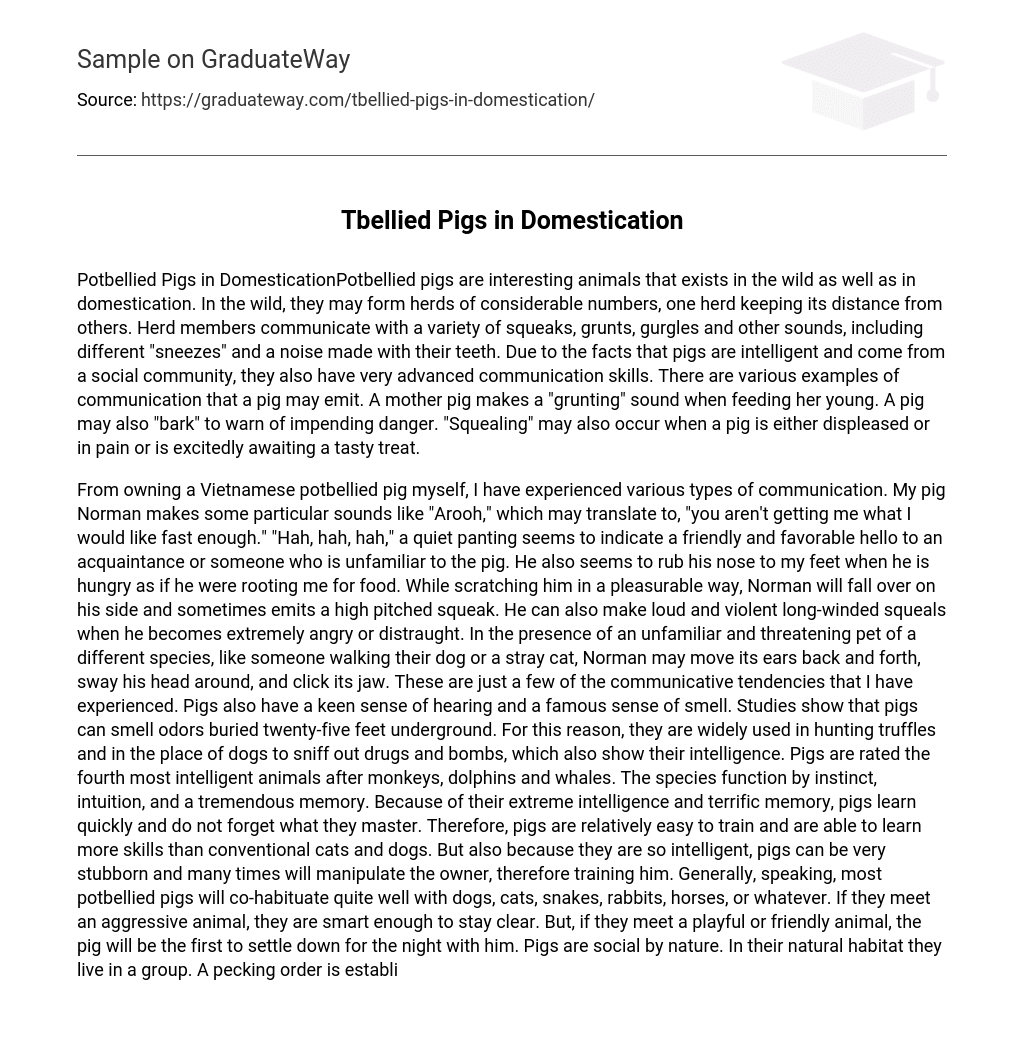Potbellied Pigs in DomesticationPotbellied pigs are interesting animals that exists in the wild as well as in domestication. In the wild, they may form herds of considerable numbers, one herd keeping its distance from others. Herd members communicate with a variety of squeaks, grunts, gurgles and other sounds, including different “sneezes” and a noise made with their teeth. Due to the facts that pigs are intelligent and come from a social community, they also have very advanced communication skills. There are various examples of communication that a pig may emit. A mother pig makes a “grunting” sound when feeding her young. A pig may also “bark” to warn of impending danger. “Squealing” may also occur when a pig is either displeased or in pain or is excitedly awaiting a tasty treat.
From owning a Vietnamese potbellied pig myself, I have experienced various types of communication. My pig Norman makes some particular sounds like “Arooh,” which may translate to, “you aren’t getting me what I would like fast enough.” “Hah, hah, hah,” a quiet panting seems to indicate a friendly and favorable hello to an acquaintance or someone who is unfamiliar to the pig. He also seems to rub his nose to my feet when he is hungry as if he were rooting me for food. While scratching him in a pleasurable way, Norman will fall over on his side and sometimes emits a high pitched squeak. He can also make loud and violent long-winded squeals when he becomes extremely angry or distraught. In the presence of an unfamiliar and threatening pet of a different species, like someone walking their dog or a stray cat, Norman may move its ears back and forth, sway his head around, and click its jaw. These are just a few of the communicative tendencies that I have experienced. Pigs also have a keen sense of hearing and a famous sense of smell. Studies show that pigs can smell odors buried twenty-five feet underground. For this reason, they are widely used in hunting truffles and in the place of dogs to sniff out drugs and bombs, which also show their intelligence. Pigs are rated the fourth most intelligent animals after monkeys, dolphins and whales. The species function by instinct, intuition, and a tremendous memory. Because of their extreme intelligence and terrific memory, pigs learn quickly and do not forget what they master. Therefore, pigs are relatively easy to train and are able to learn more skills than conventional cats and dogs. But also because they are so intelligent, pigs can be very stubborn and many times will manipulate the owner, therefore training him. Generally, speaking, most potbellied pigs will co-habituate quite well with dogs, cats, snakes, rabbits, horses, or whatever. If they meet an aggressive animal, they are smart enough to stay clear. But, if they meet a playful or friendly animal, the pig will be the first to settle down for the night with him. Pigs are social by nature. In their natural habitat they live in a group. A pecking order is established and maintained by body and verbal pig language. Pigs think of themselves equal to you. The important thing to remember is that you need to establish yourself at the top of the social hierarchy in your home or your pig will determine that he is “top pig” and dictate the rules of the roost. Because pigs are social creatures, they may become bored and restless when they are expected to spend inordinate amounts of time alone without either human or other animal interactions. Hence, you need to be creative in providing a pet pig with entertaining distractions. A contented pig huffs around making quiet, satisfied noises that are very pleasing. You may even decide to adopt a pair of pigs to ensure that you never have a bored or lonely pet.





